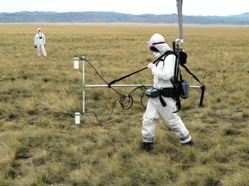
The test itself would be expected to modify the density, and to some extent the chemistry, of the rock at depth. Because of the heat released, one would also expect that the groundwater table would be disrupted. Changes to groundwater chemistry may also be detectable. The cavity formed by the explosion may be imaged directly, as may the immediate zone of influence within the rock and groundwater. Tunnels, shafts or other excavations created to place the device at depth may also be detectable.
Depending on the specific case, any combination of microgravity, deep electrical imaging or active seismics would be appropriate techniques to use. They are used in mining and mineral exploration, as well as possibly during underground coal gasification projects or in the geological disposal of nuclear waste.
The inspected state may put forward its own explanation for the suspect event - a natural earthquake, for example, or an induced event caused by mining or a natural void collapse; and indeed it is perfectly possible that no illegal activity has occurred (as in our exercise). If the official line is that the area under investigation is an old industrial site, the tell-tale geophysical signatures (service runs, pipelines, foundations, storage tanks, buried waste, contamination, etc.) are something we have become very familiar with in our woirk on brownfield sites across the world. Such experience is crucial; since drilling is not allowed until the final phase of the inspection process (if at all) the correct and careful application of geophysical techniques is critical to the success of an inspection.
In the months to come, State Signatories and the CTBTO will revisit the exercise by sifting through the many reports, assessments and documents that were produced. Future exercises will be conducted to determine how much has been learned from the lessons gained at the Integrated Field Exercise 2008 in Kazakhstan.
*George Tuckwell is a director of the Geophysical division at STATS Ltd (RSK Group), and is a Vice President of the Geological Society. The views expressed herein are those of the author and do not necessarily reflect the views of the CTBTO Preparatory Commission.